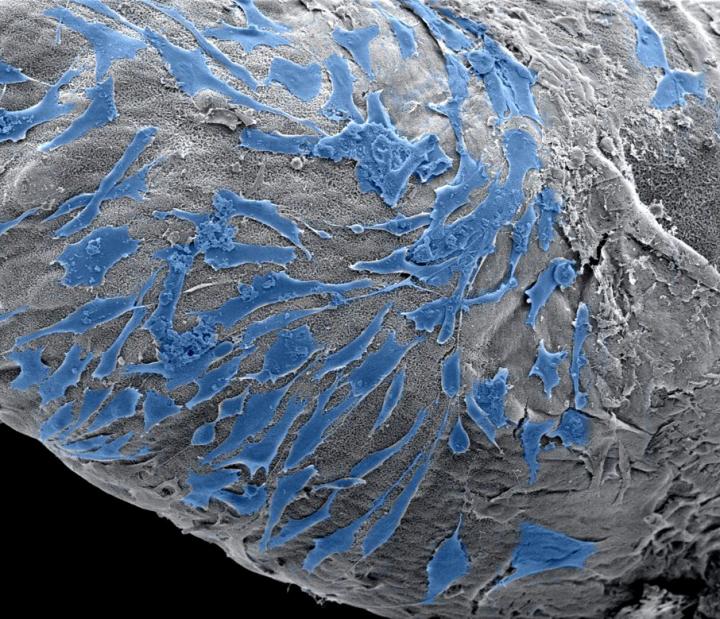New printing technique uses cells and molecules to recreate biological structures

These are cells spreading on the outside of a PA based scaffold. Credit: Clara Hedegaard
These structures are embedded in an ink which is similar to their native environment and opens the possibility to make them behave as they would in the body.
This allows the researchers to observe how cells work within these environments and potentially enables them to study biological scenarios such as where cancer grows or how immune cells interact with other cells, which could lead to the development of new drugs.
The technique combines molecular self-assembly, building structures by assembling molecules like Lego pieces, with additive manufacturing, similar to 3D printing, to recreate the complex structures.
The structures can be manufactured under digital control and with molecular precision which also enables the researchers to create constructs that mimic body parts or tissues for tissue engineering or regenerative medicine.
The study is published in Advanced Functional Materials.
Professor Alvaro Mata, from Queen Mary's School of Engineering and Materials Science, said: “The technique opens the possibility to design and create biological scenarios like complex and specific cell environments, which can be used in different fields such as tissue engineering by creating constructs that resemble tissues or in vitro models that can be used to test drugs in a more efficient manner.”
The technique integrates the micro- and macroscopic control of structural features that printing provides with the molecular and nano-scale control enabled by self-assembly. Because of this, it addresses a major need in 3D printing where commonly used printing inks have limited capacity to actively stimulate the cells that are being printed.
PhD student Clara Hedegaard, leading author of the paper, added: “This method enables the possibility to build 3D structures by printing multiple types of biomolecules capable of assembling into well defined structures at multiple scales. Because of this, the self-assembling ink provides an opportunity to control the chemical and physical properties during and after printing, which can be tuned to stimulate cell behaviour.”
###
The study was carried out in collaboration with the Nanyang Technological University in Singapore and the University of Oxford.
It was supported by the European Research Council's Starting Grant (STROFUNSCAFF), the FP7-PEOPLE-2013-CIG Biomorph, the Royal Society, and the European Space Agency's Drop My Thesis program 2016.
Media Contact
All latest news from the category: Life Sciences and Chemistry
Articles and reports from the Life Sciences and chemistry area deal with applied and basic research into modern biology, chemistry and human medicine.
Valuable information can be found on a range of life sciences fields including bacteriology, biochemistry, bionics, bioinformatics, biophysics, biotechnology, genetics, geobotany, human biology, marine biology, microbiology, molecular biology, cellular biology, zoology, bioinorganic chemistry, microchemistry and environmental chemistry.
Newest articles

NASA: Mystery of life’s handedness deepens
The mystery of why life uses molecules with specific orientations has deepened with a NASA-funded discovery that RNA — a key molecule thought to have potentially held the instructions for…

What are the effects of historic lithium mining on water quality?
Study reveals low levels of common contaminants but high levels of other elements in waters associated with an abandoned lithium mine. Lithium ore and mining waste from a historic lithium…

Quantum-inspired design boosts efficiency of heat-to-electricity conversion
Rice engineers take unconventional route to improving thermophotovoltaic systems. Researchers at Rice University have found a new way to improve a key element of thermophotovoltaic (TPV) systems, which convert heat…



